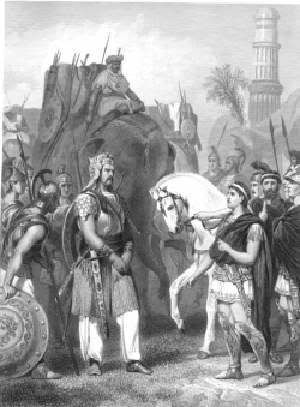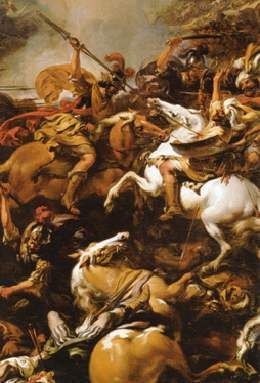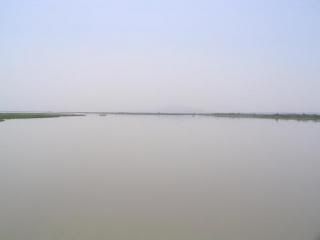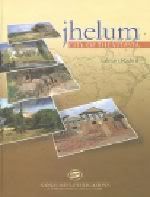 The name Jhelum reminds of Alexander from Macedonian who came to the South Asia sometime in 326 BC.
The name Jhelum reminds of Alexander from Macedonian who came to the South Asia sometime in 326 BC.
He moved from Taxila of Raja Ambhi, whom he subdued without fight, to Kalar Kahar. From there he moved over the Salt Range, turning left, along the western bank of River Jhelum, which he called Hydaspes. He encamped in area of present village Darapur
(a monument is under construction at the site of the camp). Opposite him on the other bank was a Raja Porus. They fought Alexander’s biggest Indian battle which Alexander won, achieving a masterly surprise against the valiant Rajput.
Before moving further, along the river Alexander established a village on west bank of the River and ordered construction of 2000 boats. Greek Admiral Nearches was to arrange wood from nearby higher hills which would be floated down the River and hauled up at this point. He called this village as Boucephila (Present Jhelum city). The Jhelum River passes vying with the residential areas of the city. The mosque inside the river is a famous landmark most commuters on the Grand Trunk Road see even today.
 Alexander’s Naval Chief was assigned the task of boats building on a very large scale. Therefore, the craftsmen on a large scale were gathered, hence the modern colonies in the city were named as Machine Mohallahs (Number1, 2 and 3), because of saw mills. Jhelum became timber market for whole of Punjab over the millenniums. It was only after construction of Mangla Dam that log wood does not float down the River and the city has lost this privilege. There is a plywood factory also, which is flourishing.
Alexander’s Naval Chief was assigned the task of boats building on a very large scale. Therefore, the craftsmen on a large scale were gathered, hence the modern colonies in the city were named as Machine Mohallahs (Number1, 2 and 3), because of saw mills. Jhelum became timber market for whole of Punjab over the millenniums. It was only after construction of Mangla Dam that log wood does not float down the River and the city has lost this privilege. There is a plywood factory also, which is flourishing.
Greeks left marks of their chivalry and martial spirit which mixed up well with the races and clans dwelling in the area. Later, various races such as Turks, Hunas, Persians, Afghans, Mongols, and others including Mehmood of Ghazana, Muhammad Ghauri, Taimur, Babar and their descendants and followers, are found to have campaigned in this strategic region enormously. People who settled here adopted pastoral life and indulged in stock rearing, agriculture came later and soldiering in regular form still much later. Along with the martial races sprang up the artisans, craftsmen, skilled professionals of technical trades for the society to flourish in peace, as a whole.
The British, after annexation of Punjab in 1849 from Sikhs, established administration at district level and Jhelum District, which originally was covering large area including Pindigheb and territory up to River Indus, was delimited later to include tehsils of Jhelum, Chakwal and Pind Dadan Khan, with District Head Quarters shifting from Pind Dadan Khan to Jhelum. During the 20th Century, this city has a proud history of chivalry and achievements.
During World War I, Jhelum provided maximum number of soldiers as a result of which the British recruited very extensively from Jhelum, till their last days of rule. First Victoria Cross, the highest award for gallantry was earned by Subedar Khuda Dad Khan during World War I. Later its equivalent (Nishan-e-Haider) of Pakistan has been won by Major (Shaheed) Raja Muhammad Akram during our war of 1971. At the time of partition of the subcontinent, three out of four senior major generals of Pakistan Army were from Jhelum: Major General Muhammad Akbar commonly known as “recruit⠀�, Major General Nazir Ahmed and Major General Muhammad Iftekhar. Senior most Pakistan Air Force officer was Air Commodore Muhammad Khan Janjua, also from Jhelum.
Later rose up two service chiefs with four star rank, General Asif Nawaz Janjua and Admiral Tariq Kamal Khan. Colonel Muhammad Khan, the author of Bajang Amad and Bazam Araian, and poet Zamir Jafri too have their roots here. Inder Kumar Gujral, who later served as Indian Prime Minister, migrated to India from Jhelum. Military College Jhelum (actually located at Srai Alamgir – town across River Jhelum) was established during the British era. Stone laying was done by the British Prince of Wales, later king Edward the 8th. First entry of students, in 1925, included ‘Alamigirian seniors like Brig Sultan Khan and Brig (Senator) Muhammad Hayat. The institute is now the premier one with top class results, in the country, academically.
Military College Jhelum (actually located at Srai Alamgir – town across River Jhelum) was established during the British era. Stone laying was done by the British Prince of Wales, later king Edward the 8th. First entry of students, in 1925, included ‘Alamigirian seniors like Brig Sultan Khan and Brig (Senator) Muhammad Hayat. The institute is now the premier one with top class results, in the country, academically.
During Pakistan’s wars, officers and other ranks excelled in their performances and a very large number of gallantry awards were won. One has to read Citations of such acts of valour. Then pre World War II and during that war, the number of Junior commissioned officers (earlier-Viceroy Commissioned) who rose to honorary ranks of lieutenants and captains would run into hundreds. Predominance in Defence Services continues and so is service to country.
The people of Jhelum are not sweet for nothing; they have the best quality of Rush Orange (Lockat) grown in salt range. The Jhelum valley (Pabbi area and parts of Salt Range) has been producing pure honey which is rare. In early days, some Yogies and men who indulged in medicine practice had established a centre at Tilla Jogi, because of special growth of useful herbs and plants. Another sweet preparation, a gift from the central square in the city is called ‘Amrassaâà ¢â€šÂ¬Ã¢â€žÂ¢. This sweet is a roasted preparation of rice flour, in pure milk ghee and is usually in small pieces like candies. It is sweet enough only for the taste and is hardly a bar even for diabetics. It is long lasting and its packs would make fine gifts. Do not miss this sweet when visiting Jhelum.
 Jhelum is known for variety of animals and birds and some rare species of deer (huryal). Emperor Jahangir availed of deer shoot in the eastern extremities of the Salt Range (near Rohtas). It is still available but rare. Thanks to unlawful hunting that this specie is at the verge of extinction. Brown partridge, pigeons, sand grouse, quails and some other birds are still to be found. And for bird watchers, there is no other place in this region having such a variety. It is just heavenly a large variety of hymning birds, numerous species of beautiful little sparrows, multi-coloured birds of various sizes, king fishers, birds of falcon family, green parrots, wood peckers, birds of peace, robins. This region provides food and sanctuaries to all of them. Early morning tunes (starting at pre dawn) of their routine singing activity is a treat that can only be personally experienced.
Jhelum is known for variety of animals and birds and some rare species of deer (huryal). Emperor Jahangir availed of deer shoot in the eastern extremities of the Salt Range (near Rohtas). It is still available but rare. Thanks to unlawful hunting that this specie is at the verge of extinction. Brown partridge, pigeons, sand grouse, quails and some other birds are still to be found. And for bird watchers, there is no other place in this region having such a variety. It is just heavenly a large variety of hymning birds, numerous species of beautiful little sparrows, multi-coloured birds of various sizes, king fishers, birds of falcon family, green parrots, wood peckers, birds of peace, robins. This region provides food and sanctuaries to all of them. Early morning tunes (starting at pre dawn) of their routine singing activity is a treat that can only be personally experienced.
Jhelum Work Force which moved into the Gulf States when the latter embarked on their development, financed by oil boon. This force is second to none. There are people of all trades and technologies. The reputation this Work Force has earned makes it most desired. Besides the Middle East, Pakistanis, including medical and engineering fields, are serving well in the US, Canada, Britain and other European countries. Only no body is taking pains to develop the human resources of the country optimally.
It is generally believed in the area that British were really intrigued by one phenomena that people of a particular plateau or valley were found to be tall and strong so they conducted a research; only to come to conclusion that it was the “waterâà ¢â€šÂ¬Ã‚? and ‘saltââ� �€šÂ¬Ã¢â€žÂ¢ of that particular area which is the secret.
The Grand Trunk Road and main Karachi Peshawar Railway Track pass through the city. Commuters can have a feeling of the town once they cross through. Besides history, the city has a rural touch and nothing much have changed here during last couple of decades.



















































Dear Pakistaniat
Assalamo aleikum
I have been visiting this interesting site from time to time as I did my doctoral research on Pakistani history and culture, and have been a regular visitor to your warm and hospitable country since 1995.
I enjoyed reading this article on Jehlum by Mr Shirazi and would please like to some comments/corrections:
1. ‘Beucephalia’, named after Alexander of Macedon’s horse Beucephalus (‘Ox-Head’ lit.)is generally associated by archaeologists with the small city of Phalia, near Jehlum, and there is evidence that this was probably the site where the horse was also buried after the battle against Porus.
2. According to the War Office(UK) Records for WWI and WWII, the ‘contribution’ of Punjabi forces to the British Indian Army, districtwise, were: (1) Attock; (2) Jehlum and (3) Chakwal. The Sikh-majority areas of East Punjab followed.
Thank you.
Great post. Very informative.
[quote post=”584″]Many historians believe that people in afghansitan and NWFP have blue eyes and fair skin infact have greek blood in them.[/quote]
Greeks rarely have blue eyes. They predominantly have black or brown eyes, and dark hairs.
On same note, research shows the Kalash as the ramanents of Alaxander’s army.
[quote post=”584″]1) In Quran, there is a mention of a great king(Surah 18: Al Kahf). Many religious scolars believe that it was Alexander the great, and that he was a prophet & a muslim. Please refer to this surah for details.[/quote]
Does not seem relevant here. We don’t need to look the scriptures to confirm widley accepted historical facts. Alexander, the great, a Muslim? Ummm. What about Artistotle, Archimedes and others?
Pretty informative article. Having some interest in History I wanted to mention something about Alexander the Great. I am not sure how much of these are historical facts and how much are just theories or the myths:
1) In Quran, there is a mention of a great king(Surah 18: Al Kahf). Many religious scolars believe that it was Alexander the great, and that he was a prophet & a muslim. Please refer to this surah for details.
2) It was custom of the armies at that time to marry local women whereever they went. Many historians believe that people in afghansitan and NWFP have blue eyes and fair skin infact have greek blood in them.
3)There is some research and data which suggests that present time afghanistan looks like a community of biblical times. Aleza Goldsmith mentions in one of his lectures that there were around 40, 000 jews living in afghanistan at the start of 20th century. Some historian state: “They may very possibly have gone there with the dispersion of the Ten Tribes of Israel in 722 BCE. Many ended up there after the destruction of the first Temple.” Some claim that the city of Kabul “stands for Cain and Abel” and that the name Afghanistan is derived from the grandson of King Saul of the tribe of Benjamin, Afghana.
You can also read more on this site:
http://www.jewishsf.com/content/2-0-/module/displa ystory/story_id/17088/edition_id/337/format/html/d isplaystory.html
Again, many believe that it was during the invasion of Alexander that people setlled in afghanistan in BC.
As i said earlier, some are theories and many could be facts.
Great post!
Shirazi: Excellent post. I have learned more about my country from your posts on ATP than all of my other sources combined. Your accounts are often first hand and narratives strait forward and non complicated. The Potohar Plateau of Pakistan is a fascinating place both from historical and geographical point of view and who else to cover it than a native son like yourself. Thank you sir.